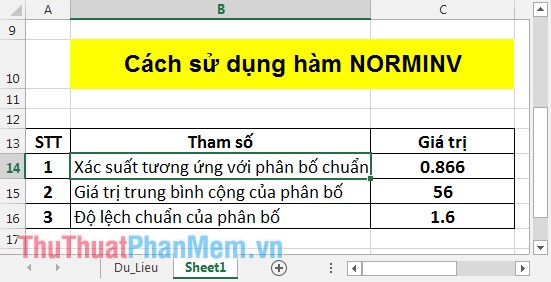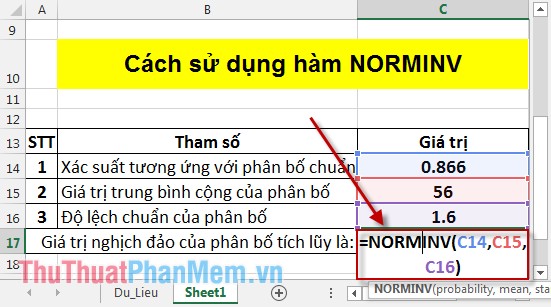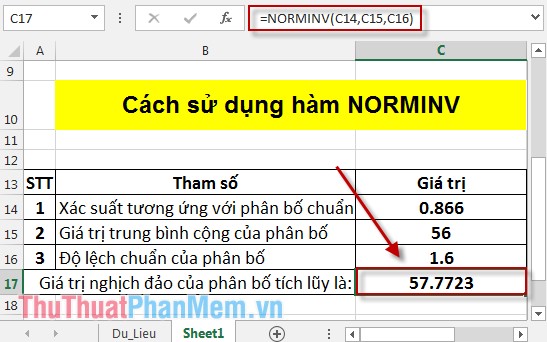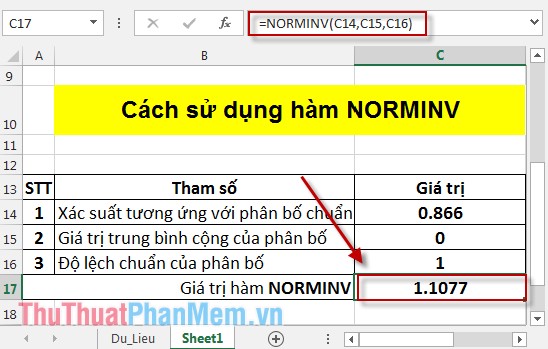NORMINV function - The function returns the inverse of the cumulative distribution in Excel
The following article details how to use the NORMINV function - The function returns the inverse of the cumulative distribution in excel.
Description: The function returns the inverse of the cumulative distribution with the standard deviation and a defined mean. The NORMINV function uses the iterative search technique, if the search after 100 times has not converged => the function returns the value # N / A.
Syntax: NORMINV (probability, mean, standard_dev) .
Inside:
- probability: Probability corresponding to the normal distribution, is a required parameter.
- mean: The average value of the distribution, is a required parameter.
- standard_dev: The standard deviation of the distribution, is a required parameter.
Attention:
- The parameters in the NORMINV function must be numeric, otherwise the #VALUE!
- Probability value is in the range: 0 < probability <1, otherwise the function returns the #NUM! Error value.
- Required value standard_dev> 0, otherwise the error message #NUM!
- Where mean = 0 and standard_dev = 1 => the distribution becomes the normalized distribution and the NORMINV value of the distribution = NORMSINV value of the distribution.
For example:
Calculate the inverse value of the standard cumulative distribution with the following parameters:

In the cell to calculate the value enter the following formula: = NORMINV (C14, C15, C16) .

Press Enter to get the result:

In case the NORMINV function has mean = 0 and standard_dev = 1 => the NORMINV function value is:

This value is exactly equal to the value of the NORMSINV function with the same corresponding probability:

So when the NORMINV function has mean = 0 and standard_dev = 1 , the value is exactly the same as the NORMSINV function .
The above details in detail how to use the NORMINV function in statistical probability. Hope to help you.
Good luck!
You should read it
- GAMMA.INV function - The function returns the inverse of the gamma distribution in Excel
- LOGNORM.INV function - The function returns the inverse of the logarithmic distribution of x in Excel
- T.INV function - The function returns the inverse value of the Student t distribution in Excel
- F.INV function - The function returns the inverse of the probability distribution F in Excel
- F.INV.RT function - The function returns the right-inverse head value of the probability distribution F in Excel
- T.INV.2T - The function returns the two-sided inverse of the Student's t-distribution in Excel
 QUARTILE function - The function returns the quartile of a dataset in Excel
QUARTILE function - The function returns the quartile of a dataset in Excel Instructions to save Excel files as PDFs in Office 2010, 2013, 2016
Instructions to save Excel files as PDFs in Office 2010, 2013, 2016 Hide and display columns and rows in Excel
Hide and display columns and rows in Excel Notes when typing formulas to avoid typing errors in Excel
Notes when typing formulas to avoid typing errors in Excel Instructions and examples of array formulas Array Formulas in Excel
Instructions and examples of array formulas Array Formulas in Excel How to create a frequency chart in Excel
How to create a frequency chart in Excel